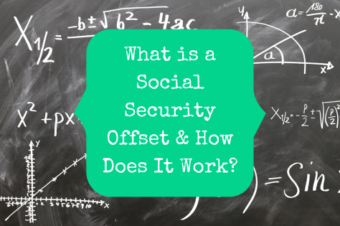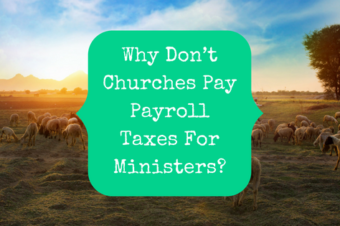
With our current economic crisis brought on by the coronavirus, Congress and the President have been taking action to relieve some of the burdens for taxpayers and businesses. One area where they are providing a break is payroll taxes, the taxes paid to fund the Social Security and Medicare programs. If you have opted out of Social Security, then this article does not apply to you. If you aren’t exempt, then this article is very important for you, since you are a dual status taxpayer.
How Payroll Taxes Work For Pastors
Being a dual status taxpayer means that even if you are employed by a church, you have to pay your payroll taxes as if you were self-employed. For normal employees, payroll taxes are split evenly between the employer and the employee. The employer pays 7.65% of the employee’s income to the government and the employee also pays 7.65%.
When a person is self-employed, they hold both roles of employer and employee. Thus, they have to pay 7.65% as the employer and another 7.65% as the employee for a total of 15.3% of their income in self-employment payroll taxes. Pastors have to pay these taxes as if they were self-employed, even if they really are employed by a church. As such, pastors pay the full 15.3% tax and the church that employs them pays nothing.
Self-Employment Taxes Deferred Under The CARES Act
Congress passed the Coronavirus, Aid, Relief and Economic Security (CARES) Act at the end of March and the President signed it into law. Part of that Act allowed employers to defer paying payroll taxes. It applies to payroll taxes on income earned between March 27, 2020, when the Act was signed into law, and December 31, 2020. Employees still have to pay their 7.65%, but employers are allowed to put off paying it until later.
How does that affect pastors? The CARES Act allows pastors to defer payment of half of their self-employment taxes, which represent the employer portion. Half of the deferred taxes are due by December 31, 2021, and the other half is due by December 31, 2022. That means that you only have to pay 7.65% of self-employment taxes between March 27 and December 31 of this year and you won’t be penalized for not paying the full 15.3%. However, you will have to pay the taxes eventually, half in 2021 and half in 2022.
The Presidential Memorandum On Payroll Tax Deferral
On August 8, 2020, President Trump issued a Memorandum on Deferring Payroll Tax Obligations in Light of the Ongoing COVID-19 Disaster. A presidential memorandum is also called an executive order and is a directive, not a law, since laws must be passed by Congress.
This particular executive order directs the Secretary of the Treasury “to use his authority to defer certain payroll tax obligations with respect to the American workers most in need.” It provides for a deferral of the employee portion of payroll taxes incurred between September 1, 2020, to December 31, 2020. As with the CARES Act, half of the deferred taxes would be due December 31, 2021, and the other half would be due December 31, 2022. The deferral only applies to people who make less than $4,000 bi-weekly, which is about $104,000 a year.
The memorandum also states, “The Secretary of the Treasury shall explore avenues, including legislation, to eliminate the obligation to pay the taxes deferred pursuant to the implementation of this memorandum.” The President doesn’t want people to have to pay those payroll taxes at all. He just doesn’t have the authority to do that, so he’s asking the Secretary of the Treasury to look for a way. The executive order doesn’t say how this will be implemented practically. It’s the Secretary of the Treasury’s job to figure that out and let everyone know.
Should Pastors Defer Their Payroll Taxes?
Between the CARES Act and the executive order, you can defer half of the self-employment taxes due on income earned between March 27, 2020, and August 31, 2020, and all of the payroll taxes you would usually owe for work done between September 1, 2020, and December 31, 2020. Should you do it?
My first question would be, do you need to? Are you struggling to feed your family and keep the lights on? Then I would say you should take advantage of any relief you can get. But, if you’re doing fine and have no trouble paying the taxes, I would probably just pay them. This is only a deferral, so you’ll have to pay them eventually. If you don’t pay them now, you’ll likely have to pay them in addition to your current payroll taxes over the next two years.
Remember, though, this is just my opinion without knowing the facts of your situation. Look at your own numbers and what is going on in your life, pray about it, and do what God says, even if it’s the opposite of what I say.
One thing to note, under the CARES Act you will not get a refund of deferred amounts when you file your Form 1040 next spring. If you pay the full 15.3%, you won’t be able to get half of that back just because you weren’t required to pay it.
How To Calculate Self-Employment Taxes With The Deferral
If you do decide to defer your payroll taxes, how do you calculate that? If you are only deferring the employer portion per the CARES Act, then you would take your income for the period in question and multiply it by 0.0765 to find 7.65%. That’s all you would pay. If you usually calculate it all together, then take what you would normally pay and subtract the 7.65%. If you are deferring the entire amount after September 1, then you could follow the same method but use 15.3% for your calculations.
Another option is to use this online tax withholding calculator. It is designed for pastors and the results break down the taxes due into federal income taxes, Medicare, Social Security, and state income taxes. Remember, the taxes you are allowed to defer are the Medicare and Social Security taxes, not the income taxes. To calculate your estimated quarterly payments, just use the withholding calculator and lower the amount you pay by the Medicare and Social Security tax numbers.
Because this is all so new and not clearly defined, the IRS does not have a strict method that you have to use for your calculations. Their website says that “an individual may use any reasonable method” for their calculations. Basically, try your best to do it right and you should be fine. Don’t sweat the details.



